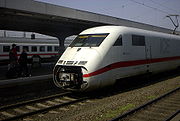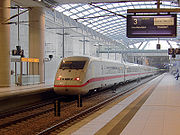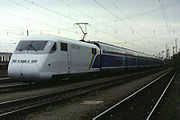
DBAG Class 402
Encyclopedia
This article is about the train. For the Bridgman form of water ice, see Ice II
.
The ICE 2 is the second series of German high-speed trains and one of five in the Intercity-Express family since 1995.
The ICE 2 (half-)trains are even closer to a conventional push-pull
train than the ICE 1, because each train consists of only one power car
(Class 402, called powerhead), six passenger cars (Classes 805 to 807) and a cab car (Class 808).

 Except for the automatic coupling, ICE 2 powerheads are very similar to those of the ICE 1 and can actually be used in ICE 1 trains if strictly necessary.
Except for the automatic coupling, ICE 2 powerheads are very similar to those of the ICE 1 and can actually be used in ICE 1 trains if strictly necessary.
Until the class 808 cab cars have been tested and cleared for passenger service, two ICE 2 half-trains had been solidly coupled to form a permanent block train.
.
ICE 2 trains have no service car as the class 803 on ICE 1 trains, on the other hand the class 808 cab car is unique to the ICE 2.
with two unit block train. In Hamm
the train is separated into two half-trains.
One half-train goes through the Ruhr area
to Cologne Bonn Airport
, while the other half-train continues through Wuppertal
and Cologne
to Bonn
. In the opposite direction, both half-trains are coupled again at Hamm.
Some trains also serve the Munich
—Hanover
line with halves continuing to Hamburg
and Bremen
respectively.

Eurotrain was a joint venture formed by Siemens
and GEC-Alsthom (today Alstom
) in 1996 to market high-speed rail technology in Asia. In 1997, it was one of two competitors to supply the core system of Taiwan High Speed Rail
(THSR), and was awarded the status of preferred bidder by concessionaire THSRC.
In early 1998, the two companies created a demonstration train by combining cars of three existing French and German high-speed trains: ICE 2 powerheads 402 042 and 402 046, were joined at both ends to the articulated double-deck intermediate cars of TGV Duplex
trainset #224. On 4 May 1998, the Eurotrain demonstration train made a presentation run on the Hanover–Würzburg high-speed railway in Germany, achieving a maximum speed of 316 km/h.
In December 2000, THSRC decided to award the contract to the rival Taiwan Shinkansen Consortium, leading to a legal battle ending in damage payments for Eurotrain in 2004.
Ice II
Ice II is a rhombohedral crystalline form of ice with highly ordered structure. It is formed from ice Ih by compressing it at temperature of 198 K at 300 MPa or by decompressing ice V. When heated it undergoes transformation to ice III....
.
The ICE 2 is the second series of German high-speed trains and one of five in the Intercity-Express family since 1995.
The ICE 2 (half-)trains are even closer to a conventional push-pull
Push-pull
Push–pull may refer to:In electronic technology:*Push–pull output, type of electronic circuit*Push–pull converter, in electronics, is a type of DC to DC converter that uses a transformer*Push–pull connector, an electronic cable connector...
train than the ICE 1, because each train consists of only one power car
Power car
A power car is a railroad vehicle that is closely related to the locomotive. What differentiates the two is their construction or their use. A true locomotive can be physically separated from its train and does nothing but provide propulsion . A power car, on the other hand, is frequently an...
(Class 402, called powerhead), six passenger cars (Classes 805 to 807) and a cab car (Class 808).
Differences to ICE 1


Half-trains
Usually two ICE 2 half-trains are coupled to form a block train of similar dimensions to the original ICE 1 for serving the main routes, and separated again to operate on routes with less traffic or to provide the passengers two different destinations.Until the class 808 cab cars have been tested and cleared for passenger service, two ICE 2 half-trains had been solidly coupled to form a permanent block train.
Cars
The passenger cars are very different from the ICE 1 cars, despite their similar exterior: The weight has been significantly reduced and the passenger compartments have been removed in favor of a seating arrangement similar to an airliner (due to reduced seat pitch). Also, the train has been equipped with air suspension to circumvent the wheel noise problems of the ICE 1, which led to the installation of rubber-buffered wheel rims on the ICE 1 units and therefore the Eschede train disasterEschede train disaster
The Eschede train disaster was the world's deadliest high-speed train accident. It occurred on 3 June 1998, near the village of Eschede in the Celle district of Lower Saxony, Germany. The toll of 101 people dead and 88 injured surpassed the 1971 Dahlerau train disaster as the deadliest accident in...
.
ICE 2 trains have no service car as the class 803 on ICE 1 trains, on the other hand the class 808 cab car is unique to the ICE 2.
Service
ICE 2 trains usually run on the main east-west line, starting in BerlinBerlin
Berlin is the capital city of Germany and is one of the 16 states of Germany. With a population of 3.45 million people, Berlin is Germany's largest city. It is the second most populous city proper and the seventh most populous urban area in the European Union...
with two unit block train. In Hamm
Hamm
Hamm is a city in North Rhine-Westphalia , Germany. It is located in the northeastern part of the Ruhr area. As of December 2003 its population was 180,849. The city is situated between the A1 motorway and A2 motorway...
the train is separated into two half-trains.
One half-train goes through the Ruhr area
Ruhr Area
The Ruhr, by German-speaking geographers and historians more accurately called Ruhr district or Ruhr region , is an urban area in North Rhine-Westphalia, Germany. With 4435 km² and a population of some 5.2 million , it is the largest urban agglomeration in Germany...
to Cologne Bonn Airport
Cologne Bonn Airport
Cologne/Bonn Airport is an international airport located in the district of Porz in the city of Cologne, Germany, and is surrounded by the Wahner Heide nature reserve. The airport is centrally located in the Cologne/Bonn Region southeast of Cologne city centre and northeast of Bonn...
, while the other half-train continues through Wuppertal
Wuppertal
Wuppertal is a city in North Rhine-Westphalia, Germany. It is located in and around the Wupper river valley, and is situated east of the city of Düsseldorf and south of the Ruhr area. With a population of approximately 350,000, it is the largest city in the Bergisches Land...
and Cologne
Cologne
Cologne is Germany's fourth-largest city , and is the largest city both in the Germany Federal State of North Rhine-Westphalia and within the Rhine-Ruhr Metropolitan Area, one of the major European metropolitan areas with more than ten million inhabitants.Cologne is located on both sides of the...
to Bonn
Bonn
Bonn is the 19th largest city in Germany. Located in the Cologne/Bonn Region, about 25 kilometres south of Cologne on the river Rhine in the State of North Rhine-Westphalia, it was the capital of West Germany from 1949 to 1990 and the official seat of government of united Germany from 1990 to 1999....
. In the opposite direction, both half-trains are coupled again at Hamm.
Some trains also serve the Munich
Munich
Munich The city's motto is "" . Before 2006, it was "Weltstadt mit Herz" . Its native name, , is derived from the Old High German Munichen, meaning "by the monks' place". The city's name derives from the monks of the Benedictine order who founded the city; hence the monk depicted on the city's coat...
—Hanover
Hanover
Hanover or Hannover, on the river Leine, is the capital of the federal state of Lower Saxony , Germany and was once by personal union the family seat of the Hanoverian Kings of Great Britain, under their title as the dukes of Brunswick-Lüneburg...
line with halves continuing to Hamburg
Hamburg
-History:The first historic name for the city was, according to Claudius Ptolemy's reports, Treva.But the city takes its modern name, Hamburg, from the first permanent building on the site, a castle whose construction was ordered by the Emperor Charlemagne in AD 808...
and Bremen
Bremen
The City Municipality of Bremen is a Hanseatic city in northwestern Germany. A commercial and industrial city with a major port on the river Weser, Bremen is part of the Bremen-Oldenburg metropolitan area . Bremen is the second most populous city in North Germany and tenth in Germany.Bremen is...
respectively.
Eurotrain

Eurotrain was a joint venture formed by Siemens
Siemens
Siemens may refer toSiemens, a German family name carried by generations of telecommunications industrialists, including:* Werner von Siemens , inventor, founder of Siemens AG...
and GEC-Alsthom (today Alstom
Alstom
Alstom is a large multinational conglomerate which holds interests in the power generation and transport markets. According to the company website, in the years 2010-2011 Alstom had annual sales of over €20.9 billion, and employed more than 85,000 people in 70 countries. Alstom's headquarters are...
) in 1996 to market high-speed rail technology in Asia. In 1997, it was one of two competitors to supply the core system of Taiwan High Speed Rail
Taiwan High Speed Rail
Taiwan High Speed Rail is a high-speed rail line that runs approximately along the west coast of the Republic of China from the national capital of Taipei to the southern city of Kaohsiung...
(THSR), and was awarded the status of preferred bidder by concessionaire THSRC.
In early 1998, the two companies created a demonstration train by combining cars of three existing French and German high-speed trains: ICE 2 powerheads 402 042 and 402 046, were joined at both ends to the articulated double-deck intermediate cars of TGV Duplex
SNCF TGV Duplex
The TGV Duplex is a French high-speed train of the TGV family, operated by SNCF, the French national railway company. It is unique among TGV trains in that it features bi-level carriages. The Duplex inaugurated the third generation of TGV trainsets, and was specially designed to increase capacity...
trainset #224. On 4 May 1998, the Eurotrain demonstration train made a presentation run on the Hanover–Würzburg high-speed railway in Germany, achieving a maximum speed of 316 km/h.
In December 2000, THSRC decided to award the contract to the rival Taiwan Shinkansen Consortium, leading to a legal battle ending in damage payments for Eurotrain in 2004.
External links
- ICE 2 Siemens Page

